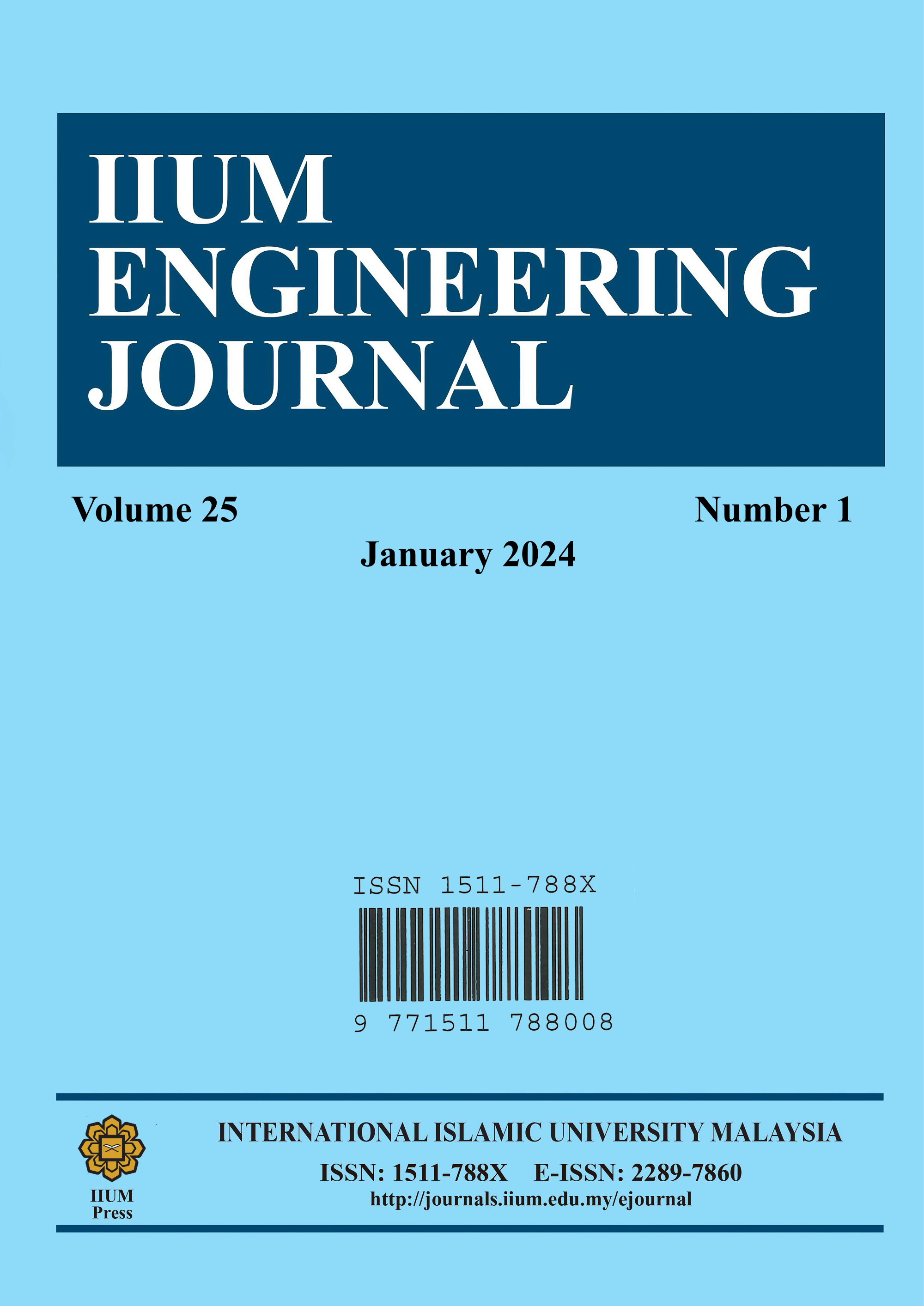THE INFLUENCE OF PLANT GROWTH REGULATORS AND LIGHT SUPPLY ON BITTER CASSAVA CALLUS INITIATION FOR STARCH PRODUCTION
DOI:
https://doi.org/10.31436/iiumej.v25i1.2585Keywords:
Cassava, Callus culture, 2,4-Dichlorophenoxyacetic acid (2,4-D), 6-Benzylaminopurine (BAP), lightAbstract
The application of cassava starch in the biopolymers industry has been growing significantly due to its low cost, good oxygen barrier in the dry state, and biodegradability. Plant culture technology is an alternative to traditional propagation as it does not require large areas for production, has a higher rate of multiplication, and produces disease-free plants. However, the application of cassava callus culture for starch production is limited. This study focuses on identifying the significant culture parameters for a maximum Rayong cultivar cassava callus growth and evaluation of its starch content. Cassava stems petiole and leaf explants were cultured on MS medium containing different combinations of 2,4-D (8, 12, and 15 mg/L) and BAP (1, 3, and 5 mg/L) under three light conditions (0, 16, and 24 h). The screening of the most influential parameter was done using the 2-level Factorial Design in Design Expert v13 by analyzing the frequency of callus formation. All leaf explant turned brown with no callus induction. The highest frequency of callus formation derived from stem petiole explant was achieved by the combination of 8 mg/L 2,4-D and 1 mg/L BAP under the light condition (75%) followed by 8 mg/L 2,4 D + 1 mg/L BAP under the dark condition (50%). Based on the ANOVA analysis, the individual supply of 2,4-D and BAP respectively, have a negative effect on callus formation while the combination of 2,4-D and BAP has a positive effect. Light supply did not significantly affect cassava callus formation. The amount of starch in the cassava callus was then investigated using an iodine test which yielded 0.21% of the total weight of the callus (0.0101g). The amount of starch is relatively low considering that the callus was not grown under the optimum condition for starch production. The findings of this study open prospects for future research in cassava cultures in favor of starch production.
ABSTRAK: Penggunaan kanji ubi kayu dalam industri biopolimer telah meningkat secara mendadak disebabkan oleh faktor kosnya yang rendah, rintangan oksigen yang baik dan sifat keterbiodegradasi. Teknologi kultur tisu tumbuhan merupakan alternatif kepada pembiakan secara tradisional yang mana teknologi ini tidak memerlukan kawasan penanaman yang luas, penghasilan yang lebih singkat dan menghasilkan tumbuhan bebas penyakit. Walau bagaimanapun, kajian mengenai penggunaan kanji dari kultur ubi kayu masih belum meluas. Kajian ini bertujuan mengenal pasti parameter penting dalam pertumbuhan maksimum kalus kultivar ubi kayu Rayong dan kandungan kanjinya. Eksplan dari tangkai petiol dan daun ubi kayu dikulturkan dalam medium MS yang mengandungi pelbagai kombinasi hormon tumbuhan 2,4-D (8, 12 dan 15 mg/L) dan BAP (1, 3 dan 5 mg/L) di bawah tiga tempoh masa pencahayaan (0, 16 dan 24 jam). Saringan parameter paling berpengaruh dilakukan menerusi reka bentuk faktorial 2-peringkat perisian Design Expert v13 melalui analisa frekuensi pembentukan kalus. Semua eksplan daun telah bertukar dari hijau ke perang dan tidak menunjukkan induksi kalus. Bagi eksplan batang daun, frekuensi pembentukan kalus tertinggi diperoleh dari kombinasi 8 mg/L 2,4-D dan 1 mg/L BAP di bawah pencahayaan 24 jam (75%) diikuti dengan 8 mg/L 2,4 D + 1 mg/L BAP di bawah pencahayaan malap (50%). Berdasarkan analisis ANOVA, medium 2,4-D dan BAP masing-masing menunjukkan kesan negatif kepada pembentukan kalus, sementara kombinasi 2,4-D dan BAP memberikan kesan positif. Dapatan ini menunjukkan bahawa pencahayaan tidak signifikan terhadap pembentukan kalus kultur ubi kayu. Kandungan kanji di dalam kalus ubi kayu kemudiannya diuji dengan larutan iodin, dan menunjukkan dapatan sebanyak 0.21% dari berat kalus (0.0101 g). Secara relatif, nilai ini adalah rendah memandangkan eksperimen ini bukan dihasilkan di bawah keadaan optimum bagi pembentukan kanji. Hasil kajian ini membuka peluang kepada kajian-kajian lain di masa hadapan dalam penghasilan kanji dari kultur tisu ubi kayu.
Downloads
Metrics
References
Tan SL. (2015) Cassava – Silently, The Tuber Fills. UTAR Agriculture Science Journal, 1(2): 12-24.
Li S, Cui Y, Zhou Y, Luo Z, Liu J, Zhao M. (2017) The industrial applications of cassava: current status, opportunities and prospects. Journal of the Science of Food and Agriculture, 97(8): 2282-2290. https://doi.org/10.1002/JSFA.8287 DOI: https://doi.org/10.1002/jsfa.8287
Tumwesigye KS, Oliveira JC, Namuwaya S, Sousa-Gallagher MJ. (2021) Cassava Biomaterial Innovations for Industry Applications. In (Ed.), Cassava - Biology, Production, and Use. IntechOpen. https://doi.org/10.5772/intechopen.97493 DOI: https://doi.org/10.5772/intechopen.97493
Cassava Starch Market, Consumption & Global Forecast. Available: https://www.renub.com/cassava-starch-market-p.php
Howeler R, Cain P, Trumbore L, Hidajat SU. (2012) The challenge of large-scale cassava production. Sustainable Cassava Production in Asia for Multiple Uses and for Multiple Markets Proceedings 9th Regional Cassava Workshop, 313-321.
NurulNahar E, Tan, SL. (2012) Cassava mini-cuttings as a source of planting material, J. Trop. Agric. and Fd. Sc., 40(1): 145-151.
Hussain A, Ahmed I, Nazir H, Ullah I. (2012) Plant Tissue Culture: Current Status and Opportunities. Recent Advances in Plant in Vitro Culture, 37(3): 5-30. https://doi.org/10.5772/50568 DOI: https://doi.org/10.5772/50568
Abdalla N, Ragab M, El-Miniawy S, Taha H. (2013) Callus induction, regeneration and molecular characterization of cassava (Manihot esculenta Crantz). Journal of Applied Sciences Research, 9: 3781-3790.
Faye A, Sagna M, Kane PD, Sane D. (2015) Effects of different hormones on organogenesis in vitro of some varieties of cassava (Manihot esculenta Crantz) grown in Senegal. African Journal of Plant Science, 9(8): 305-312. doi:https://doi.org/10.5897/AJPS2014.1243 DOI: https://doi.org/10.5897/AJPS2014.1243
Mahdi H, Edward R. (2018) In vitro propagation of selected Malaysia cassava (Manihot esculenta Crantz) varieties by using nodal explants. Malaysian Applied Biology, 47(1): 1-5.
Prammanee S. Kamprerasart K, Salakan S, Sriroth K. (2010) Growth and starch content evaluation on newly released cassava cultivars, Rayong 9, Rayong 7 and Rayong 80 at different
harvest times. Kasetsart J., 44: 558-563.
Fletcher EKA, Amoako TNE, Twumasi P. (2011) Effect of 2,4-D, explants type and cultivar on the callogenesis expression of cassava (Manihot esculenta Crantz) in Ghana. African Journal of Biotechnology, 10(46):9396-9401. https://doi.org/10.5897/ajb10.2115 DOI: https://doi.org/10.5897/AJB10.2115
Puad NIM, Sofri NSNM, Amid A, Azmi AS. (2022) Optimization of Surface Sterilization Method and Initiation of Bitter Cassava Callus Culture. Biological and Natural Resources Engineering Journal, 6(1): 47-59.
Puad NIM, Tang CW. (2015) A simple and Easy Method for Preparing Solid and Liquid Media for Plant Culture. Experimental Methods in Modern Biotechnology (vol. 3). IIUM Press, Malaysia.
Reddy DK, Bhotmange MG. (2013) Isolation of Starch from Rice (Oryza sativa L.) and its Morphological Study using Scanning Electron Microscopy. International Journal of Agriculture and Food Science Technology, 4(9): 859-866.
Bello OA, Esan EB, Obembe OO. (2018) Establishing surface sterilization protocol for nodal culture of Solanecio biafrae. IOP Conference Series: Earth and Environmental Science, 210: 012007. https://doi.org/10.1088/1755-1315/210/1/012007 DOI: https://doi.org/10.1088/1755-1315/210/1/012007
Hesami M, Naderi R, Tohidfar M, Yoosefzadeh-Najafabadi M. (2019) Modeling and Optimizing in vitro Sterilization of Chrysanthemum via Multilayer Perceptron-Non-dominated Sorting Genetic Algorithm-II (MLP-NSGAII). Frontiers in Plant Science, 10. https://doi.org/10.3389/fpls.2019.00282 DOI: https://doi.org/10.3389/fpls.2019.00282
Anderson MJ, Whitcomb PJ. (2015) Two-level Factorial Design. DOE Simplified: Practical Tools for Effective Experimentation, www.statease.com.
Ullah H, Ullah I, Jadoon SA, Rashid H. (2007) Tissue culture techniques for callus induction in rice. Sarhad J. Agric, 23(1), 81-86.
Bano AS, Khattak AM, Basit A, Alam M, Shah ST, Ahmad N, Gilani SAQ, Ullah I, Anwar S, Mohamed HI. (2022) Callus Induction, Proliferation, Enhanced Secondary Metabolites Production and Antioxidants Activity of Salvia moorcroftiana L. as Influenced by Combinations of Auxin, Cytokinin and Melatonin. Brazilian Archives of Biology and Technology, 65: e22210200. https://doi.org/10.1590/1678-4324-2022210200 DOI: https://doi.org/10.1590/1678-4324-2022210200
Junairiah J, Purnomo P, Utami ESW, Ni‘matuzahroh N, Sulistyorini, L. (2018) Callus Induction of Piper betle L. Var Nigra Using 2,4-Dichlorofenoxyacetic Acid and 6-Benzil Aminopurin. Biosaintifika: Journal of Biology & Biology Education, 10(3): 588-596. doi:https://doi.org/10.15294/biosaintifika.v10i3.15962 DOI: https://doi.org/10.15294/biosaintifika.v10i3.15962
Chutipaijit S, Sutjaritvorakul T. (2018) Titanium dioxide (TiO2) nanoparticles induced callus induction and plant regeneration of indica rice cultivars (suphanburi1 and suphanburi90). Digest Journal of Nanomaterials and Biostructures, 13(4): 1003-1010.
Ozarowski M. (2011) Influence of the physico-chemical factors, plant growth regulators, elicitors and type of explants on callus cultures of medicinal climbers of Passiflora l. L. Herba Polonica, 57(4): 58-75.
Carciofi M, Blennow A, Nielsen MM, Holm PB, Hebelstrup KH. (2012) Barley callus: a model system for bioengineering of starch in cereals. Plant Methods, 8(1): 1-10. https://doi.org/10.1186/1746-4811-8-36 DOI: https://doi.org/10.1186/1746-4811-8-36
Efferth T. (2019) Biotechnology Applications of Plant Callus Cultures. Engineering, 5(1): 50-59. https://doi.org/10.1016/j.eng.2018.11.006 DOI: https://doi.org/10.1016/j.eng.2018.11.006
Lee ST, Huang WL. (2013) Cytokinin, auxin, and abscisic acid affects sucrose metabolism conduce to de novo shoot organogenesis in rice (Oryza sativa L.) callus. Botanical Studies, 54(1): 1-11. https://doi.org/10.1186/1999-3110-54-5 DOI: https://doi.org/10.1186/1999-3110-54-5
Downloads
Published
How to Cite
Issue
Section
License
Copyright (c) 2023 IIUM Press

This work is licensed under a Creative Commons Attribution-NonCommercial 4.0 International License.
Funding data
-
Ministry of Higher Education, Malaysia
Grant numbers FRGS/1/2021/STG01/UIAM/02/2 -
Research Management Centre, International Islamic University Malaysia
Grant numbers RMCG20-018-0018






















